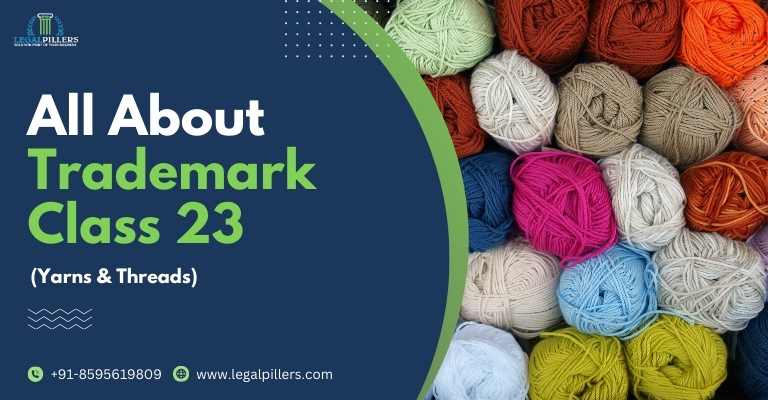
Table of Contents
All About Trademark Class 23
Trademark Class 23, according to the Nice Classification system, is a category that specifically relates to textiles and textile goods. It encompasses a wide range of products made from natural or synthetic fibres. Some of the items that fall under Class 23 include yarns and threads for textile use, as well as various textile materials for use in clothing, upholstery, and household textiles. Additionally, Class 23 includes specific products like ropes, nets, and tents, which are often constructed from textile materials. This class is essential for trademark registration purposes to distinguish and protect trademarks associated with these types of goods.
Important goods included in Trademark Class 23
Trademark class 23 mainly includes natural or synthetic yarns and threads for textile use. The goods included in this class of trademark are as given below-
- Fiberglass, elastic, rubber, and plastic threads for textile use.
- Threads for embroidery, darning, and sewing, including those of metal
- Spun silk, spun cotton, spun wool
Goods does not included in Trademark Class 23
- Certain threads for specific uses, for instance,-
- Identification threads for electric wires (included in class 9)
- Surgical thread (included in class 10)
- Threads of precious metal being jewellery (included in class 14)
- Threads, other than for textile use, that are classified according to the material of which they are made, for example,-
- Threads for binding of metal (included in class 6)
- Threads for binding, not of metal (included in class 22)
- Elastic threads, threads of rubber or plastic (included in class 17)
- Fiberglass threads (included in class 21)
List of popular examples of Trademark Class 23
- Alok Industries Ltd.: Yarn and threads of all kinds
- Arvind mill: yarns and threads for textile use.
- Vardhman: All kinds of yarn, wool, and threads.
- SRF: Yarns and threads, including fibre yarns and fibre threads
- Welspun: All kinds of threads and yarns
- Trident: Yarns and threads
- Nahar spinning: all types of yarns
- Raymond: Woolen yarn and threads of all kinds
- Rupa: Yarns and threads
List of goods classified under Trademark Class 23
C
- Chenille yarn
- Coir thread and yarn
- Cotton thread and yarn
D
- Darning thread and yarn
E
- Elastic thread and yarn for textile use
- Embroidery thread and yarn
F
- Fiberglass thread for textile use
H
- Hemp thread and yarn
J
- Jute thread and yarn
L
- Linen thread and yarn
R
- Rayon thread and yarn
- Rubber thread for textile use
S
- Sewing thread and yarn
- Silk thread and yarn
- Spun cotton
- Spun thread and yarn
- Spun wool or worsted
- Spun silk
T
- Thread of metal for embroidery
- Threads of plastic materials for textile use
W
- Woollen thread and yarn
Y
- Yarn/ thread
Scope of Trademark Class 23
Class 23 is limited to threads and yarns that are used in textile materials. Goods that are classified under other classes include finished textile products, such as clothing, towels, and bed linens. It means that if you want to protect your brand’s identity on a finished textile product, you will need to register your trademark under the appropriate class, such as Class 25 for clothing.
This class also does not cover threads and yarns that are used for non-textile purposes, such as fishing lines or ropes used in boating. These goods fall under other classes, such as Class 22 for ropes and cords and Class 28 for sporting equipment.
It is an important classification for businesses that manufacture or sell products in the textile industry. By registering their trademark under this class, they can protect their brand identity and prevent others from using similar marks or designs that could lead to customer confusion or harm to the brand.
It’s essential to note that this class covers a wide range of goods, including different types of yarns and threads used in textile materials. It includes embroidery threads, sewing threads, knitting yarns, metallic yarns, and threads made of rubber or plastic materials. It also covers braids, cords, and ribbons made of textile materials, as well as textile fibres that are not included in other classes.
Conclusion
Trademark Class 23 plays a vital role in the world of intellectual property and brand protection, specifically pertaining to textiles and textile goods. It encompasses a wide range of products, including yarns, threads, textile materials, and various textile goods used in households and industries. Registering a trademark in this class allows individuals and businesses to safeguard their brand identity within the textile industry, prevent confusion in the marketplace, and enforce their exclusive rights. It is a crucial step for businesses looking to establish and protect their presence in the textile market, and understanding the registration process is essential for successful brand management and legal protection.
LegalPillers is here to help you for reducing the complications of classification & registration of the trademark and make sure that your band has been safeguarded within this trademark class.
FAQs about Trademark Class 23
What is Trademark Class 23?
● Trademark Class 23 is a category within the Nice Classification system that covers textiles and textile goods.
What types of products are included in Class 23?
● Class 23 includes items such as yarns, threads, fabrics, textile materials, and various textile goods used in households and industries.
Why is Class 23 important for trademark registration?
● Class 23 is important because it helps businesses protect their brand identity within the textile industry and prevents others from using similar trademarks on related goods.
Who can apply for registration in Class 23?
● Individuals, businesses, or entities engaged in the manufacturing, distribution, or sale of textiles and related goods can apply for registration in Class 23.
Can I register a trademark for clothing in Class 23?
● No, clothing typically falls under Class 25, which is a separate category for apparel.
What is the Nice Classification system?
● The Nice Classification system is an international classification system used to categorize goods and services for trademark registration purposes.
How do I conduct a trademark search in Class 23?
● You can conduct a trademark search by using the online databases provided by your country’s trademark office or hiring a trademark attorney to perform a comprehensive search.
What are the benefits of registering a trademark in Class 23?
● Benefits include legal protection, market differentiation, brand recognition, licensing opportunities, and the ability to enforce exclusive rights.
How long does a Class 23 trademark registration last?
● The duration of trademark registration varies by country but is typically renewable every 10 years.
What if someone opposes my Class 23 trademark registration?
● If someone opposes your registration during the opposition period, you may need to engage in a legal process to resolve the dispute.
Can I register a trademark in multiple classes?
● Yes, you can register a trademark in multiple classes if your goods or services belong to different categories.
What is the cost of trademark registration in Class 23?
● The cost varies depending on the country and the number of classes, and it may include filing fees, attorney fees, and maintenance fees.
Is a trademark registration valid internationally?
● Trademark registrations are typically valid only within the jurisdiction where they are registered. However, you can seek international protection through mechanisms like the Madrid Protocol.
Can I amend the goods and services covered by my Class 23 trademark registration?
● Amendments to the goods and services may be possible in some cases, but they are subject to specific rules and procedures.
What should I do to maintain my Class 23 trademark registration?
● To maintain your registration, you need to renew it periodically, typically every 10 years, and continue to use the trademark in commerce.
How do I enforce my rights as a Class 23 trademark owner?
● You can enforce your rights by taking legal action against potential infringers through cease and desist letters, negotiations, or litigation if necessary.
Can I license my Class 23 trademark to other businesses?
● Yes, you can license your trademark to other businesses, allowing them to use it for specific purposes and products in Class 23.
What is the difference between a trademark and a copyright?
● Trademarks protect brand names and logos, while copyrights protect original creative works like literature, music, and art.
What is the role of a trademark attorney in the registration process?
● A trademark attorney can provide legal expertise, conduct searches, file applications, and help navigate the complexities of trademark law.
Is it possible to lose trademark protection in Class 23?
● Yes, if you fail to renew your trademark registration or if you stop using the trademark for an extended period, you may lose protection. Additionally, if a trademark becomes generic through common usage, it can lose protection.



Leave a Reply